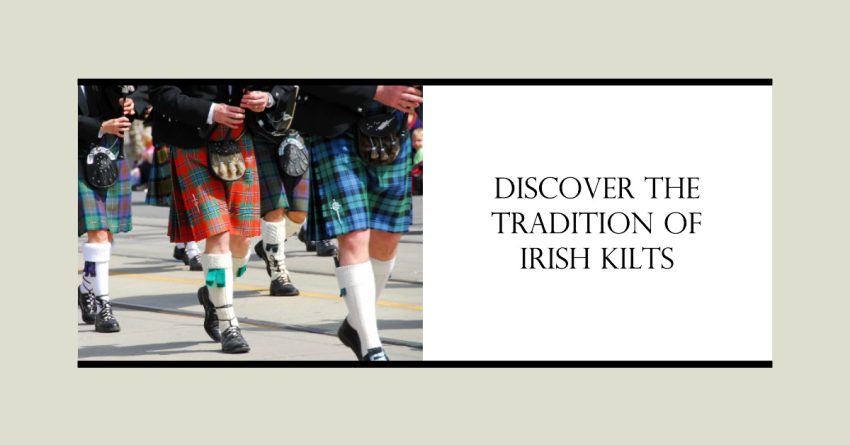Introduction
When people think of kilts, they often associate them with Scotland and its rich Celtic heritage. However, kilts are not exclusive to Scotland alone. Ireland, too, has a long-standing tradition of kilts that is deeply rooted in its history and culture. In this article, we will take a journey into the world of Irish kilts, exploring their history, symbolism, types, accessories, and much more. So, let’s delve into the fascinating tradition of Irish kilts.
History of Kilts
Kilts have a history that stretches back centuries, with their origins often traced to the Scottish Highlands. However, the concept of kilts predates their appearance in Scotland, and they were also present in Ireland. The ancient Celts, who inhabited both regions, likely wore early variations of kilts made from animal skins or woven fabrics. These early kilts served as practical garments for the Celts, providing protection and freedom of movement.
The Evolution of Irish Kilts
Over time, kilts in Ireland developed their own unique characteristics and styles. Irish kilts evolved to reflect the distinct culture, traditions, and climate of the country. While similar to Scottish kilts in some aspects, Irish kilts incorporated different patterns, colors, and materials to create a distinctive Irish flair. This evolution gave rise to a vibrant tradition of Irish kilts that continues to thrive to this day.
Traditional Irish Tartans
Tartan patterns play a significant role in the world of kilts, and Ireland boasts its own set of traditional tartans. These tartans are distinct from Scottish tartans and are associated with various Irish clans and families. Each tartan has its own unique color combinations and patterns, representing a specific lineage or region. The traditional Irish tartans hold great importance and are proudly worn by those seeking to connect with their Irish heritage.
Do Irish individuals Wear Kilts?
The wearing of kilts among Irish people is not as widespread as it is in Scotland, where kilts have a deep-rooted cultural significance. However, it is not uncommon to find Irish individuals, especially those with a strong connection to their Celtic heritage, proudly donning kilts to express their Irish identity. The popularity of wearing kilts among Irish people can vary depending on factors such as personal preference, geographical location within Ireland, and individual family traditions. While kilts may not be a ubiquitous garment in Ireland, they still hold a place of cultural importance and are embraced by those who appreciate and celebrate Irish traditions.
Read More: Do Irish men wear kilts?
Types of Irish Kilts
Irish kilts come in different styles, each with its own distinct features. The most common types include:
- The Leinster Kilt: This kilt is characterized by its pleated design and is typically made from high-quality wool. It is known for its durability and elegance.
- The Munster Kilt: The Munster kilt features intricate embroidery and is often made from a lightweight material, making it suitable for warmer weather.
- The Connacht Kilt: Connacht kilts are recognized for their unique checkered patterns. They are usually made from a blend of wool and cotton, providing both comfort and style.
Traditional Irish Kilt Accessories
To complete the traditional Irish kilt ensemble, various accessories are often worn. These include:
- The Sporran: A sporran is a pouch that hangs in front of the kilt and serves as a practical accessory for carrying small items.
- The Belt and Buckle: The belt and buckle not only provide support to the kilt but also add a decorative element to the outfit.
- The Kilt Pin: The kilt pin is worn on the front apron of the kilt and serves both a functional and decorative purpose. It adds a touch of elegance and keeps the front apron of the kilt in place.
- The Ghillie Brogues: Ghillie brogues are traditional Irish shoes worn with kilts. They feature long laces that wrap around the ankles and are designed to provide comfort and flexibility.
How to Wear an Irish Kilt
Wearing an Irish kilt requires attention to detail to ensure a proper fit and presentation. Here are the steps to wearing an Irish kilt:
- Start by putting on any necessary undergarments, such as a kilt hose and a shirt.
- Wrap the kilt around your waist, with the pleats at the back.
- Adjust the kilt to your desired length, typically just above the knee.
- Fasten the kilt with the belt and buckle, ensuring it is secure but not too tight.
- Arrange the pleats at the back of the kilt, making sure they are evenly spaced.
- Attach the kilt pin to the front apron, securing it in place.
- Complete the look with accessories like a sporran, ghillie brogues, and a jacket if desired.
The Symbolism of Irish Kilts
Irish kilts hold deep symbolism, representing both personal and cultural identities. The colors and patterns of the tartan often symbolize specific clans, families, or regions. Wearing an Irish kilt can be a way to honor one’s heritage, celebrate a sense of belonging, or simply embrace the rich cultural traditions of Ireland.
Famous Irish Kilts in History
Throughout history, certain Irish kilts have gained prominence and become iconic symbols. One notable example is the kilt worn by Irish revolutionary figures, such as Michael Collins and Eamon de Valera. These kilts represented their dedication to Irish independence and became synonymous with their leadership and courage.
Modern Irish Kilts
In modern times, Irish kilts have gained popularity beyond traditional cultural contexts. They are now worn for various occasions, including weddings, festivals, and Highland games. Irish kilts have also found their way into fashion, with contemporary designs incorporating modern fabrics, patterns, and colors.
The Popularity of Irish Kilts
The popularity of Irish kilts has grown significantly, both within Ireland and among the Irish diaspora worldwide. Many people embrace the opportunity to connect with their Irish roots and proudly display their heritage through the wearing of kilts. Additionally, the unique and visually striking nature of Irish kilts has attracted a broader audience who appreciates their beauty and cultural significance.
Irish Kilt Events and Festivals
Ireland is home to numerous events and festivals that celebrate the tradition of kilts. These gatherings provide a platform for kilt enthusiasts to come together, showcase their kilts, participate in traditional dances, and enjoy Irish music and culture. Some notable events include the Irish National Kilt Festival and St. Patrick’s Day parades, where kilts are prominently featured.
Buying an Irish Kilt
If you’re interested in owning an Irish kilt, there are several considerations to keep in mind. Look for reputable kilt makers who specialize in Irish kilts and offer high-quality craftsmanship. Ensure that the tartan you choose aligns with your family or clan heritage if you have a specific connection in mind. Take accurate measurements to ensure a proper fit and consider the desired weight and fabric of the kilt based on your preferences and the intended use.




